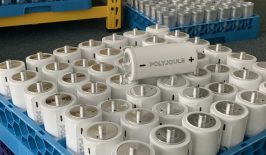Dwindling fish stocks, massive damage to ecosystems and air pollution from diesel and heavy fuel oil – the fishing industry is repeatedly criticised for its massive CO2 emissions and the damage it causes to the world’s oceans. In addition to active emissions, the destructive use of trawl nets also releases additional CO2 from sediments. According to Greenpeace, 1.9 gigatonnes of CO2 are released every year, contributing to the acidification of the oceans. Overfishing has long been known to jeopardise fish stocks worldwide. This is partly because 40 percent of the marine animals caught end up in the nets as bycatch. In short, sustainable fishing is an essential part of a successful agricultural transition.
Sustainable fishing thanks to smart sensors
Research projects such as the SUSTUNTECH project, largely funded by the EU, are working on sensor systems to advance sustainable fishing. The precise information on fish stocks and fishing success that they can provide hopes to shorten fishing routes, while saving fuel.
SUSTUNTECH stands for “Sustainable Tuna fisheries through advanced earth observation”, which sums up the objective pretty well. The aim at the start of the project in 2020 was to make tuna fishing more efficient using modern sensor technology. Shortly before the end of the project, which ends in April 2024, the sensors will be used both on boats and fishing nets themselves. The sensors will then transmit their data to a station on land via the European Copernicus satellite network. The use of satellites makes the system particularly long-range and independent both in terms of location and time.
With the help of algorithms that are becoming increasingly efficient thanks to machine learning, SUSTUNTECH can link the various data points. In addition to GPS coordinates, the information obtained also includes metrics such as water temperature or details of fish caught in the nets. According to a research report, this alone reduces the fuel consumption of a fishing fleet by 25 to 40 percent. Each individual boat can approach nets more precisely, thus covering shorter distances.
In addition, the precise localisation of fishing nets reduces so-called “ghost fishing”. This occurs when marine animals stray into lost fishing nets or other fishing gear. As they die there, unused nets pose a threat to marine ecosystems.
Combating illegal fishing with the help of satellite data
The independent organisation Global Fishing Watch is hoping to use the technology to prevent another danger. IFor fish populations to recover, commercial fishing must observe rest periods. However, rampant illegal fishing frequently disregards these rest periods and, in the worst case, leads to marine population decline. Global Fishing Watch therefore provides satellite data on the Internet in near real time, which governments and supervisory authorities can use to monitor fishing boats.
This monitoring is made possible by linking GPS data from fishing boats and satellite images, which the organisation links using cloud computing and machine learning. This increased pressure on illegal fishermen and commercial fishing companies seeks to make it harder for them not to comply with the prescribed restrictions and, simultaneously, trading companies can track whether the purchased goods actually originate from authorised fishing areas or not.
This control option does help to check where fish are being caught. However, the fishing nets themselves are a major threat to fish populations.
Fewer bycatch thanks to AI cameras
Hamburg-based Frisch Gefischt (Freshly Fished) uses an online tool to shorten the supply chain from boat to market. This, and direct communication with local fishermen, enables the company to reduce bycatch – marine animals caught by mistake that are thrown back into the sea or die in the nets.
Researchers at the Johann Heinrich von Thünen Institute are currently working on a method that could be used to avoid bycatch across the board. Using AI-supported camera systems, the researchers can already recognise fish species in the fishing nets. The system, if it works, will make it “possible to catch marine organisms with pinpoint accuracy in the medium term”. At the same time, the system enables “a resource-saving, minimally invasive investigation of fish fauna as a basis for sustainable management of the oceans”.
Even if such detection is already possible, there are currently no commercially viable systems. In the future, however, all of these systems could be available to fishing companies – which in turn poses a further threat to the ecosystems in our oceans.
New technologies always pose a risk of more exploitation
In theory, sustainable fishing could already be implemented consistently now if companies wanted to do so – or were more strongly incentivised by regulations. However, being able to detect and identify schools of fish more reliably using sensors and AI cameras also harbours the risk of misuse.
In a study, the Institute for Ecological Economy Research (IÖW) warns that smart farming must realistically lead to sustainable agriculture. These findings can also be applied to fishing. Political incentives and regulations are needed to ensure that new technologies contribute to fish population and ecosystem recovery. If this does not happen, new technologies could have the opposite effect and act as a catalyst for the further destruction of the world’s oceans.










